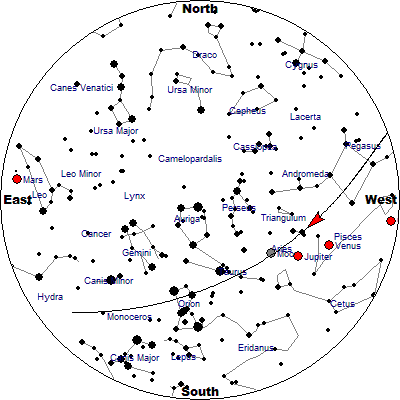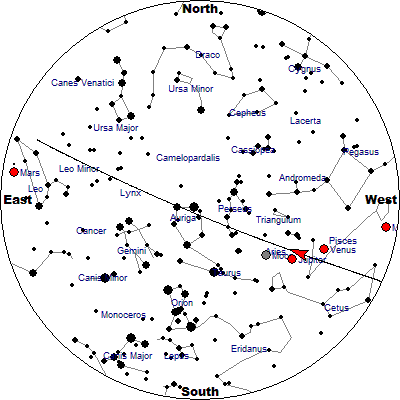Weird bright satellite on Monday
29 Feb 2012Last night was a rare semi-clear night (this month has been awful, grumble), so I was excited to see the Moon, Jupiter and Venus on my walk home from the bus stop after $WORK; it was kinda cloudy, but not completely, and anyhow the crecent moon was awful pretty through the haze. When I got home I asked my oldest son if he wanted to go out w/the telescope after supper. He was enthusiastic, so I put the 4.5" reflector outside to cool while we ate.
Forty minutes was enough to bring in more threatening clouds, but we could still see the three of them. I set up the scope and had a look at Theopilus. A couple years ago my son noticed its distinct appearance, and asked what its name was. I looked it up, and have been fond of it ever since. This time, though, he couldn't pick it out...but he was still interested, so that was good.
I'd looked on Heavens-Above to see if the ISS was due to fly overhead tonight, and it was -- just before 7pm, right when we were outside. Sweet! Sure enough, we watched closely and there it was, bright as anything and moving just past the moon. But wait, wasn't it supposed to go across the moon? What the...
...and then one minute later, there was the real ISS, and it was going across the Moon (very cool!). And there was the other satellite, almost as bright, moving on a different track. As far as I could tell, both stayed the same steady brightness -- so no tumbling for our mystery satellite. We watched both 'til they passed into the Earth's shadow, then headed inside for the night.
First thing I did, of course, was pull up Heavens-Above again to see what this other satellite was. And I couldn't find anything! There was simply nothing listed anywhere near the time the ISS flew over, let alone something that was supposed to be that bright. No Iridium flares either. Stumped, I reported to my son that I had no idea what it was.
But then I realized that I'd been looking at the listings that were supposed to be brighter than 3rd magnitude, rather than the fuller list that went down to 4.5. It was possible this thing was in the fuller list, but was brighter than predicted (because the predicted angle of reflection was wrong, say). So I pulled up the full list and started looking at tracks.
Sure enough, there were a bunch that were overhead at that time. The ISS was the most obvious one, but looking at the map tracks this Delta II rocket was the one we saw, which had launched the Globalstar 26. Here's the ISS pass:

And here's the Delta pass:

The times don't match up perfectly. The Delta was predicted to reach max altitude at 18:44 and enter shadow at 18:50; the ISS was predicted to reach 10 degrees altitude at 18:51, max at 18:54 and shadow at 18:57. I didn't note the time we saw the first one, since it was right around 18:50 and I thought it was the ISS.
I told my son about all this and -- being the son of a geek -- he thought it was pretty cool. :-)
Also -- and this is completely unrelated -- how did I not know about M-a in Emacs? Ordinarily it's "backward-sentence", but in programming modes, it moves to the beginning of non-whitespace on a line. ZOMG.
Add a comment:
Name and email required; email is not displayed.
Related Posts
QRP weekend 08 Oct 2018
Open Source Cubesat Workshop 2018 03 Oct 2018
mpd crash? try removing files in /var/lib/mpd/ 11 Aug 2018